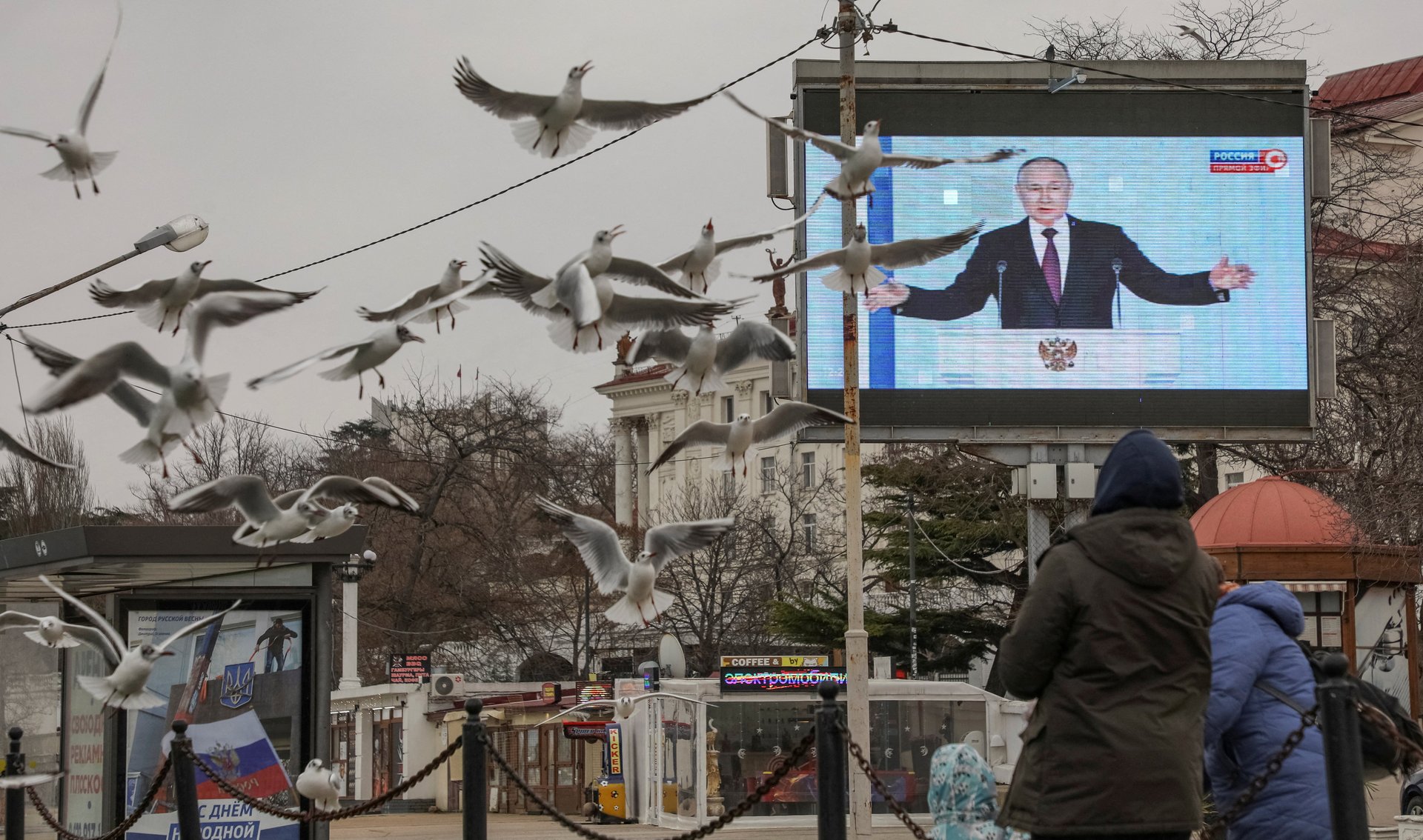Putin says he will suspend nuclear arms treaty with US
Putin blamed the US for escalating tensions during his annual State of the Nation address

Russian president Vladimir Putin announced he would suspend Moscow’s participation in the New START nuclear arms control treaty during his annual State of the Nation address on Feb 21.
Putin’s departure from a decades-long policy of nuclear disarmament came a day after US president Joe Biden visited Kyiv, where he denounced Russia’s invasion of Ukraine.
The US State Department last month declared that Russia had violated the treaty by refusing to allow international inspectors to monitor nuclear sites and ignoring Washington’s requests to hold talks on compliance. The treaty, signed by the two countries in 2010, caps the number of warheads Russia and the US can deploy, and allows for physical checks on arsenals.
US secretary of state Antony J. Blinken called Putin’s decision to suspend the treaty “deeply unfortunate and irresponsible.”
In his speech to Russian parliament, Putin also accused the US of instigating the war in Ukraine, calling Ukraine a hostage to its “Western overlords.”
Urging Russian citizens to invest in their communities and forget about foreign markets, Putin also seemed to be preparing his country for an isolated, wartime economy for years to come.
Nuclear arms treaties between the US and Russia, a timeline
1945: The US drops an atomic bomb on Hiroshima and Nagasaki, killing more than one hundred thousand people. It remains the only time a nuclear weapon has been used in conflict.
1949: The Soviet Union tests its first nuclear weapon in Kazakhstan, sparking an arms race with the US.
1953: US president Dwight D. Eisenhower calls for atomic energy to be used for advances in energy technology — instead of destruction — in his “Atoms for Peace” speech to the UN General Assembly.
1957: The International Atomic Energy Agency is founded in Vienna as a body for international cooperation on atomic research.
1962: The Soviet Union agrees to withdraw nuclear missiles from Cuba, 90 miles from the US border, after US president John F. Kennedy threatens a “full retaliatory response” to any attack on a country in the Western Hemisphere.
1963: The US, Soviet Union, and the UK, sign the Limited Test Ban Treaty banning nuclear tests in the atmosphere, outer space, and the ocean.
1968: The Soviet Union, UK, and the US sign the Treaty on the Nonproliferation of Nuclear Weapons, agreeing to pursue general disarmament. China and France joined the treaty in 1992.
1979: The US and the Soviet Union sign the SALT II Agreement that places further limits on nuclear weapons. However, president Jimmy Carter pulls out of the agreement just a year later in response to the Soviet Unions’ invasion of Afghanistan.
1983: US president Ronald Reagan dubs the Soviet Union an “evil empire” and balks at any future nuclear disarmament agreements. He also pilots the Strategic Defense Initiative, a space-based shield designed to protect the US against a nuclear attack — a departure from the theory of “mutually-assured destruction” that had so far governed nuclear arms policy.
1991: After the fall of the Soviet Union, US president George H. W. Bush and Soviet leader Mikhail Gorbachev sign the START Treaty to reduce their nuclear arsenals. It is never ratified by the US Senate.
2002: Presidents Vladimir Putin and George W. Bush sign the Moscow Treaty, which aimed to drastically cut the number of nuclear missiles in both countries.
2010: Presidents Barack Obama and Dmitry Medvedev sign a new arms reduction agreement in Prague, known as the New START Treaty.
2021: The US and Russia agree to extend the START arms reduction treaty for five more years, despite ongoing tensions. It is one of president Joe Biden’s first major foreign policy acts.
2023: Amid the Russian War in Ukraine, the US accuses Russia of violating START by refusing to allow international inspectors. A few weeks later, Putin officially suspends the agreement.
What countries have Nuclear Weapons?
Countries with Nuclear Weapons: 🇷🇺 Russia (5,977 warheads) 🇺🇸US (5,428 warheads), 🇨🇳 China (350 warheads), 🇫🇷 France (290 warheads), 🇬🇧 UK (225 warheads), 🇮🇳 India (160 warheads), 🇵🇰 Pakistan (165 warheads), 🇮🇱 Israel (unknown.)
Former countries with nuclear weapons: 🇿🇦 South Africa (voted in 1989 to voluntarily give up its nuclear weapons program), 🇧🇾 Belarus, 🇺🇦 Ukraine, and 🇰🇿 Kazakhstan (had nuclear missiles after the fall of the Soviet Union, eventually returned them to Russia).
Where does China fit into all of this?
Chinese leader Xi Jinping is expected to visit Russia to meet with Putin in the coming months, according to a recent report from the Wall Street Journal. The visit would come at a tenuous time for the alliance between Moscow and Beijing, as China attempts to position itself as a peacemaker between Ukraine and Russia.
At last week’s Munich security conference, Wang Yi—China’s top diplomat—said that China would issue a position paper on the war in Ukraine later this week. He also raised the possibility of playing a bigger role in ending the conflict.
“We are against profiting from others’ misfortune. We are advocating for peace talks,” Mr. Wang said. “We are not sitting idly by, nor are we adding fuel to the fire.”
NATO secretary-general Jens Stoltenberg, however, expressed doubt that China could facilitate dialogue between Ukraine and Russia, calling China’s plans “quite vague.”
“China has not been able to condemn the invasion,” Stoltenberg said. “China has not been able to say that this is an illegal war.”
